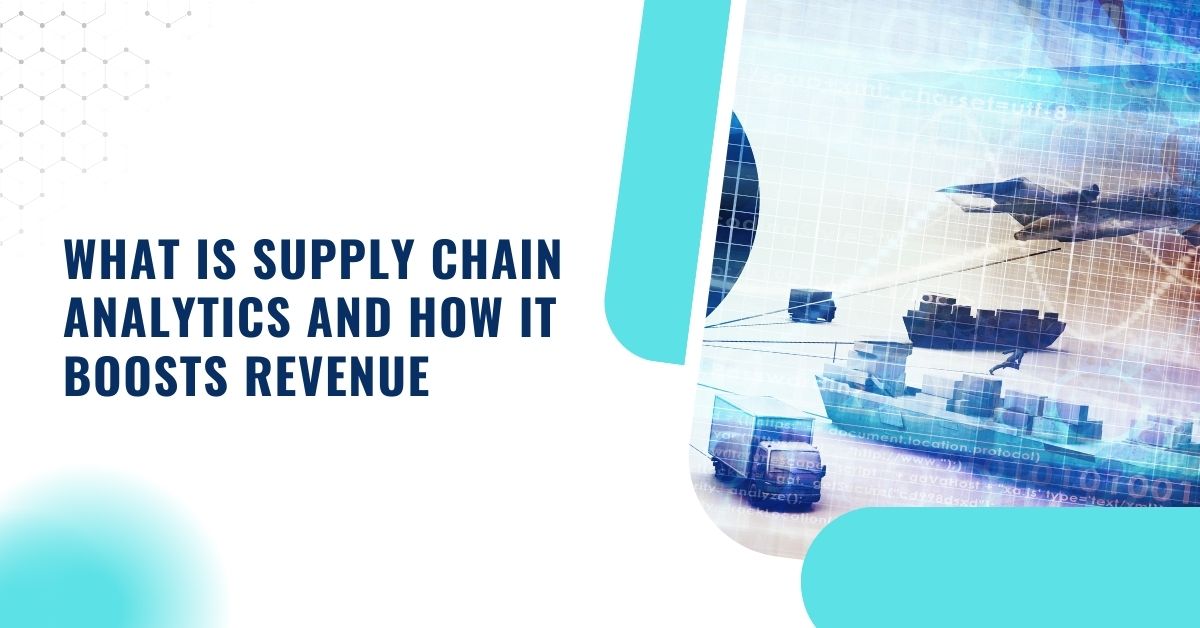If you want to improve your operations, reduce costs, and increase efficiency to boost revenue, data-driven decision-making gives you a competitive advantage in today’s business environment. To achieve this, you need supply chain analytics.
Supply chain management is an essential part of any business, and data analytics can help you optimize your supply chains. In this article, we’ll explore what supply chain analytics is and how it can boost your revenue. We’ll explain its different types and some of the challenges you can face when implementing it.
By the end of this read, you’ll have a clear understanding of how supply chain analytics can help your business make better decisions, reduce costs, and increase efficiency for increased revenue.
So, let’s dive in and see how supply chain analytics can be a game-changer for your business.
What Is Supply Chain Analytics?
Supply chain analytics is the process of collecting, analyzing, and using data to gain insights into supply chain operations. This process involves data scientists using statistical models to gain insight into the operational efficiency of your supply chains, including:
- Stock
- Inventory
- Suppliers
- Transportation
Moreover, it combines techniques and technologies like data mining, machine learning, predictive analytics, and optimization algorithms to analyze different aspects of supply chain operations. For instance, you can use it to forecast demand, determine optimal inventory levels, and plan transportation routes.

It can also assist you in identifying areas for improvement, such as reducing lead times, increasing the accuracy of forecasts, and enhancing supplier relationships. Thus, improving efficiency and reducing costs.
The graph above shows how much growth the market of supply chain analytics will grow by 2030. This is because more businesses are becoming aware of its advantages.
Understanding it and having a snippet of how it works lays the groundwork to grasp its importance and what it can do to boost your revenue. So, now let’s delve deeper into why supply chain analytics is vital to be ahead of the game.
Why Is Supply Chain Analytics Important For Your Business?
Statistical analysis using structured and unstructured data is one of the key advantages of supply chain analytics. Advanced analytics techniques like machine learning algorithms and artificial intelligence (AI) give you a deeper understanding of your supply chain network.
Data engineers play a significant role in ensuring that the data used in supply chain analytics is accurate, complete, and well-structured. They help businesses like yours collect and store data from various sources, such as ERPs, CRMs, and IoT devices, and transform it into usable formats for statistical analysis.
Here are some reasons why applying this can benefit your business:
A. Improve Operational Efficiency
It provides you with valuable insights into your supply chain data so you can optimize your supply chain planning, warehouse management, and other business processes. These actionable insights have significant business implications.

For example, let’s say you own a retail company. You can use supply chain analytics to optimize your inventory management processes. By analyzing sales data, supplier performance, and inventory levels, your team can identify slow-moving products and adjust the inventory levels as needed.
In addition, utilizing it can help your retail shop reduce carrying costs and prevent overstocking, both of which can lead to markdowns and lost revenue. Plus, you can also use supply chain analytics to identify suppliers that consistently deliver late or with low quality and take corrective action. You can then find alternative suppliers or negotiate better terms with existing ones.
In today’s highly competitive business environment, effective supply chain management and optimization are essential for achieving long-term success.
B. Improve Predictive Analytics
With the help of data analytics, your team can get valuable insights to inform your predictive models. Analyzing historical data on sales, production, inventory levels, and relevant factors allows you to:
- Predict trends
- Identify patterns
- Have a thorough understanding of your supply chain performance
For example, let’s say you have a manufacturing company. You could leverage supply chain analytics to improve production forecasting by utilizing comprehensive data, including real-time data and demand data.
Scrutinizing data on previous production runs and analyzing future outcomes lets you determine which products were most in demand and adjust your production levels accordingly. This allows you to optimize your production process so you can improve supply chain performance and increase profitability.
Furthermore, with the help of analytics tools, you can analyze your supply chain networks and identify any production delays like machine breakdowns that may have impacted production levels in the past. As such, your forecast can include when to replace, repair, or upkeep all the equipment, leading to supply chain optimization.
This helps minimize the loss of time, which is vital in business since time equals money. Ultimately, it can give you actionable insights, allowing you to make informed decisions to help grow your business.
C. Increase Supply Chain Visibility
By conducting supply chain analysis, your business can collect and analyze data generated across the entire supply chain, from raw materials to end-to-end operations, to gain insights into your overall performance.
An increase in supply chain visibility means identifying supply chain disruptions and reacting quickly. Hence, minimizing their impact and ensuring that the products are delivered on time and in good condition.

If you’re a logistics company, timely delivery of goods maintains a strong reputation and keeps customers satisfied. Supply chain analytics plays a critical role in helping you achieve this by providing greater visibility into your operations.
For instance, you could monitor shipment data like shipping times and delivery schedules to identify areas where delays are occurring. You could then use this information to adjust routes or transportation modes to reduce shipping times and improve delivery schedules.
Moreover, utilizing data science techniques can help you predict future risks and take preventive measures to avoid any negative impacts on your business. This can be particularly beneficial when working with multiple supply chain partners. It allows you to proactively plan and coordinate with them to ensure the smooth flow of goods and minimize any disruptions.
D. Reduce Inventory Costs
This can include costs associated with storage, handling, transportation, and loss because of damage. This can be a significant financial burden, especially if you’re just a start-up, as excess inventory ties up capital and storage space. This will also mean higher storage and handling costs, as well as an increased risk of spoilage.
On the other hand, stockouts result in lost sales and potential damage to customer relationships. This is when supply chain analytics come in. By analyzing historical sales data and demand patterns, you can forecast future demand and adjust inventory levels accordingly.
This results in lower storage and handling costs. Plus, it lets you make data-driven decisions that can help lower transportation costs, reduce lead times, and improve overall efficiency.
For example, let’s say you have an eCommerce store. If you notice that certain products are not selling as quickly as others, you can use supply chain analytics to identify these unsold items and adjust inventory levels accordingly to reduce excess inventory.
Additionally, you can apply it to make better decisions on inventory replenishment to minimize the need for emergency orders, which can be costly. This results in better services as orders are fulfilled promptly.
E. Boost Customer Satisfaction
When your supply chain processes are moving along without hiccups, it can improve the overall customer experience. For instance, using supply chain analytics allows you to track shipments and provide real-time updates, you can keep customers informed of delivery times and potential delays. Thus, increasing transparency, which customers will surely appreciate.

Another way that supply chain analytics can improve customer approval is by ensuring that products are delivered in the right condition. By monitoring temperature and humidity during transportation, businesses like yours can ensure that products like pharmaceutical supplies or perishable goods arrive in good condition.
In addition, analyzing customer data can help you identify consumer demand and preferences, allowing you to optimize your supply chain planning. You can know what products customers want and when they want them.
Thus, you can adjust production and inventory levels accordingly. This helps ensure that you are meeting demand, reducing the risk of stock-outs, and increasing customer satisfaction.
With supply chain analytics, you can build trust with customers. This makes it more likely for them to return to your business when you consistently deliver high-quality products.
Now that we know its importance through the many perks it brings, let’s understand its different types. You can use it as a guide to how it works and know how you can further maximize its uses by leveraging supply chain data the right way that meets your business needs.
4 Different Types Of Supply Chain Analytics: Knowing What To Leverage For Your Business
Here are four different types of supply chain analytics to provide valuable insights and help drive better decision-making.
1. Descriptive Analytics (What Happened?)
This is the use of data to understand what happened in the past and how supply chain processes and operations performed. It involves the examination of historical raw data to identify patterns, trends, and relationships between the datasets.
Leveraging analytics offers your business a comprehensive view of your supply chain operations. This type of analytics requires you to collect and organize data from internal and external sources to create a reliable source of information.

Supply chain software can provide data visualization, making it easier to identify trends, patterns, and customer demand as well as understand them. Dashboards and reports can be customized to display the most important data and metrics for your business, allowing for quick and informed decision-making.
For instance, let’s say you’re running a restaurant. You can use descriptive analytics to track the return on investment (ROI) of specific capital investments, such as new kitchen equipment or technology upgrades.
2. Diagnostic Analytics (Why Did It Happen?)
Diagnostic supply chain analytics helps identify inefficiencies and address supply chain issues. It can also provide insights that allow you to answer the following questions:
- How do we solve it?
- Why did the problem occur?
Once you answer those, you’ll have better clarity about the root cause, thus, you’ll know how to avoid the same problems from occurring in the future. With the help of data, you can make informed decisions that make supply chain processes seamless and improve overall performance to boost revenue.
For example, if you want to improve your warehouse management, you can use diagnostic analytics to determine why the inventory turnover rate is lower than expected. It can be because of delays in receiving raw materials, leading to a backlog in production and slow inventory turnover.
Using diagnostic analytics, the manager can identify the root cause of the issue and take corrective action to improve demand planning and reduce delays.
3. Predictive Analytics (What Will Happen?)
This involves using data, advanced analytics, and artificial intelligence to predict future outcomes based on current trends and past processes. This allows you to understand the business implications of certain trends related to factors like demand patterns, delivery delays, and inventory levels.

This type of data analytics is also beneficial during times of uncertainty. For example, during the pandemic, companies used predictive supply chain analytics to forecast demand in their industry and adjust their supply chain processes accordingly. You can do the same for your business.
Using predictive supply chain analytics tools for demand planning lets you identify potential risks and optimize your supply chain to meet a future scenario. So, how can you apply predictive analytics to your business?
You can use services that offer supply chain analytics software like DiLytics. We have helped numerous supply chain companies to address challenges through data analytics.

Our predictive analytics solution can enhance your decision-making process and detect revenue leakage, among other benefits if you choose to implement it. Take a look at the image above to have a snippet of our dashboard for predictive analytics.
4. Prescriptive Analytics (What Should We Do?)
Prescriptive analytics allows you to identify inefficiencies and recommend solutions to improve performance. This advanced level of supply chain analytics goes beyond just forecasting and identifying problems and instead suggests specific solutions to improve performance.
With this, you can automate decision-making based on embedded logic and real-time data. For instance, let’s say you want to change suppliers. If one of your suppliers is causing frequent delays or has quality issues, prescriptive analytics can identify the best alternative suppliers and suggest the most efficient way to transition to a new supplier.
It can analyze supply chain data and help you collaborate with logistics partners and vendors. This minimizes the risk of supply chain disruptions during the transition period and ensures that the new supplier meets your company’s requirements.
Understanding the different types of supply chain analytics is crucial for effective supply chain management. However, be aware of the challenges that come with implementing supply chain analytics in practice so you can be prepared and avoid wasting your time and resources.
Challenges Of Supply Chain Analytics
Implementing supply chain analytics can come with various challenges, including ensuring the quality and accuracy of the data collected. Integrating your analytics network with external systems can also be an issue.
These external systems can include the various suppliers and partners within the supply chain, which can have different data formats and systems that require coordination and communication. Without addressing these challenges, the insights gained from supply chain analytics may not be as effective in driving improvements in supply chain management.
So, what can you do?
You should invest in data quality management, establish clear goals and objectives, and prioritize data integration. Additionally, regular evaluation and monitoring of the data quality and ongoing training of staff are also essential.

Now that you understand the challenges of implementing supply chain analytics, you can properly evaluate the value of investing in analytics software. With that, it’s time to answer an important question.
Is It Worth It To Get Supply Chain Analytics Software?
Yes, it is. With the valuable insights you’ll get, you can better understand your customers’ demands, identify inefficiencies, mitigate risks, and make data-driven decisions to optimize your supply chain management.
While there may be some challenges associated with implementing supply chain analytics software, the benefits often outweigh them. Thus, making it a valuable investment to stay ahead of your competitors and achieve long-term success.
Conclusion
Every entrepreneur wants to set an edge to get the biggest share of the market. By leveraging the benefits of supply chain analytics, you’re one step closer to achieving that.
With the right strategies and techniques, you can make your supply chain processes seamless to reduce costs and avoid mistakes. Thus, increasing the chances for revenue growth because when everything is on time, you can slash down on your worries about profit loss.
However, continuously evaluate and adjust your productivity strategies to maintain your competitive edge. Remember, the business climate is always evolving and you always have to keep up.
So, are you ready to take your supply chain management to the next level?
Look no further than Dilytics. We have a powerful Supply Chain Planning Analytics platform that can handle complex datasets to help you take on the challenges in your niche.
We can provide you with the tools to optimize your supply chain operations, predict future demand, and make data-driven decisions. Contact us now and see how Dilytics can ensure you have the competitive edge to be on top.





